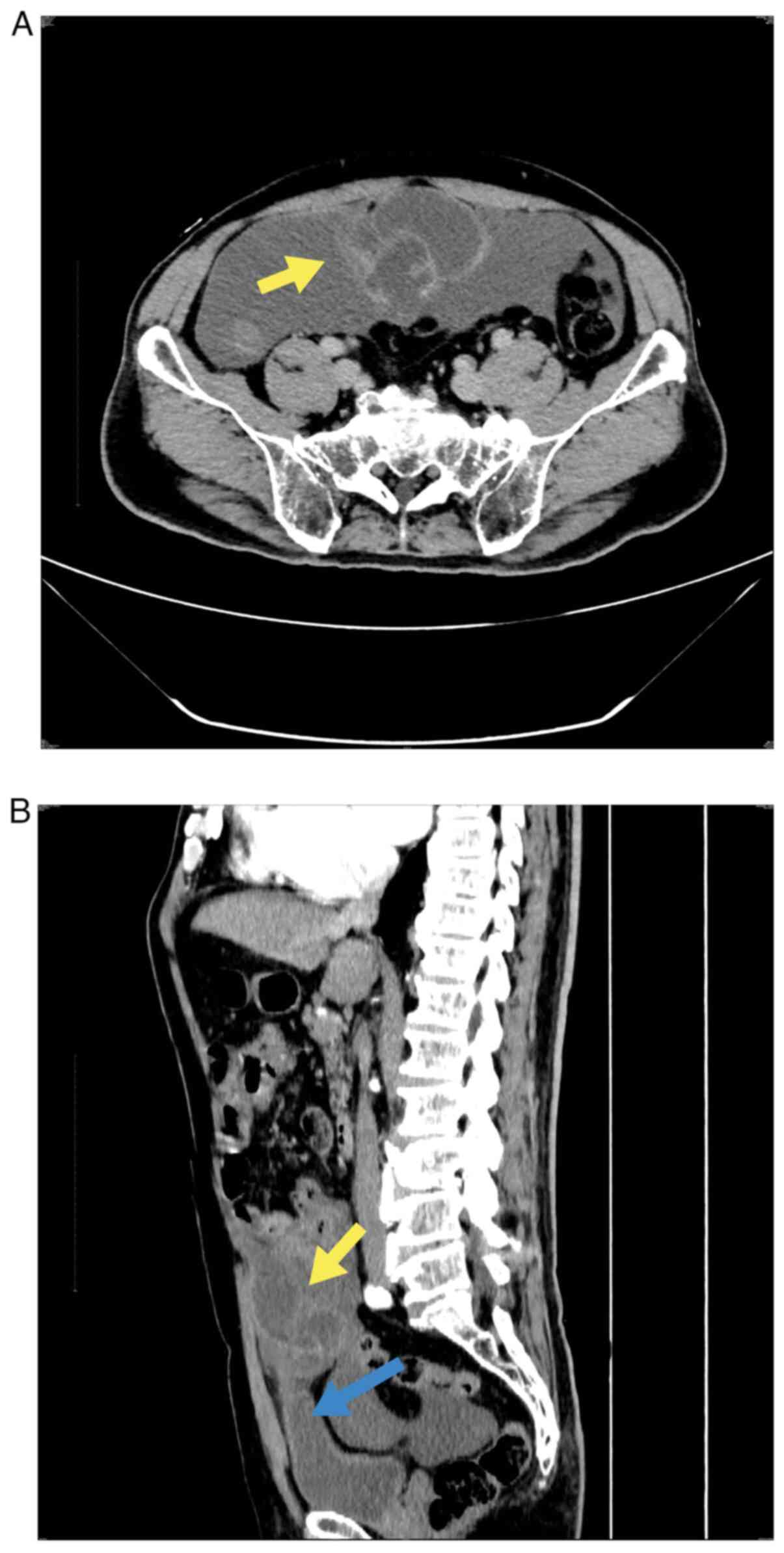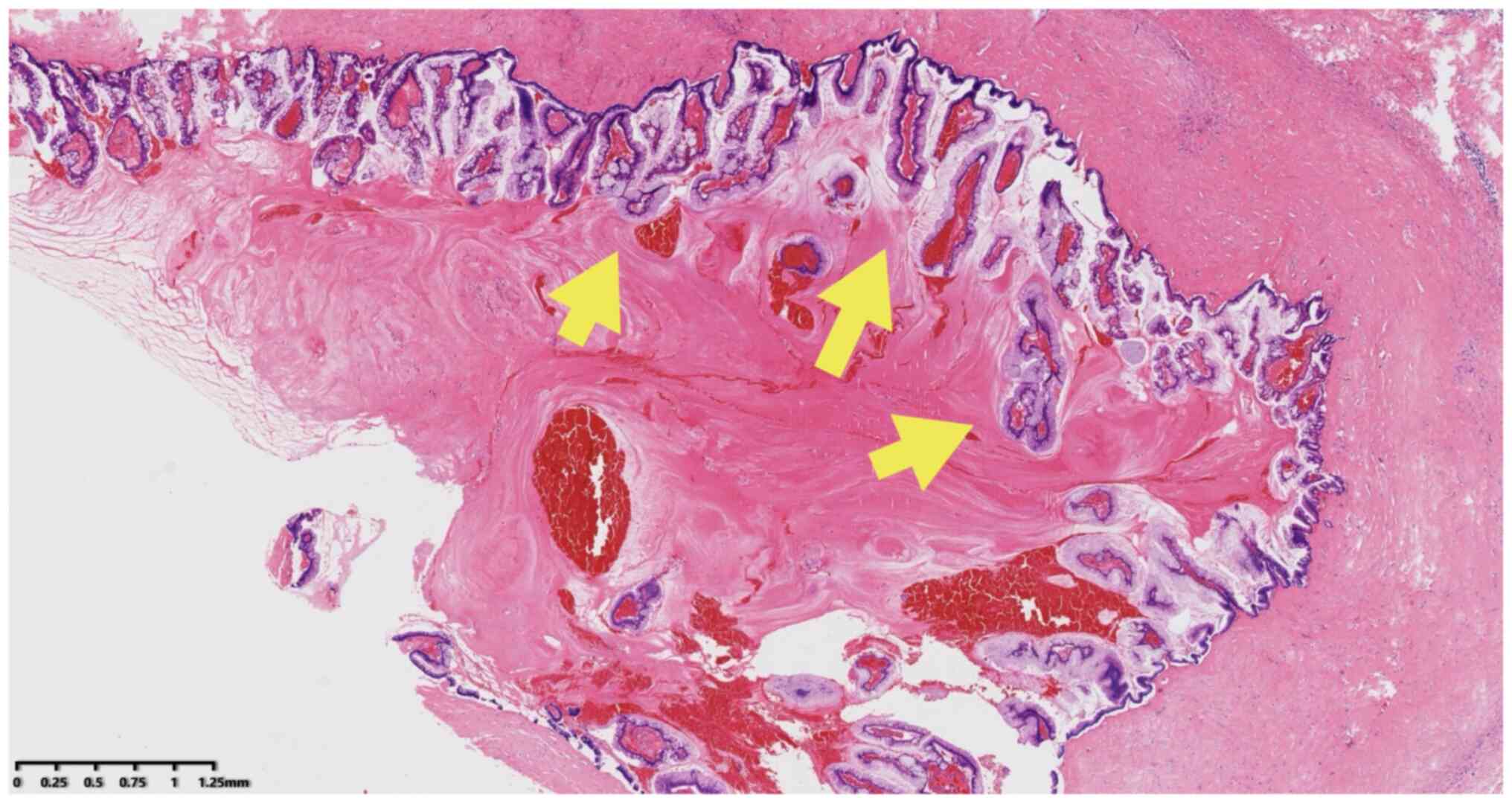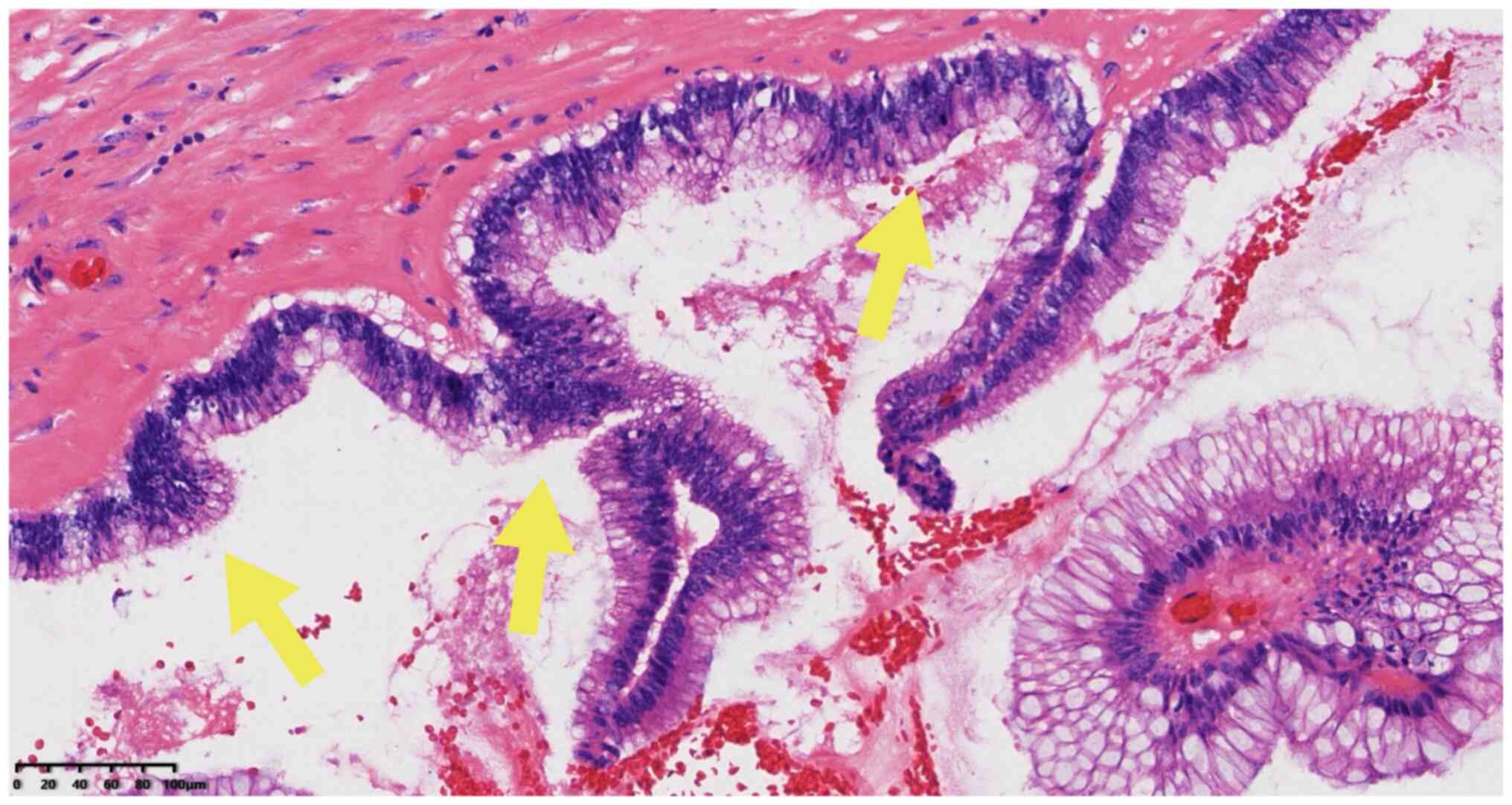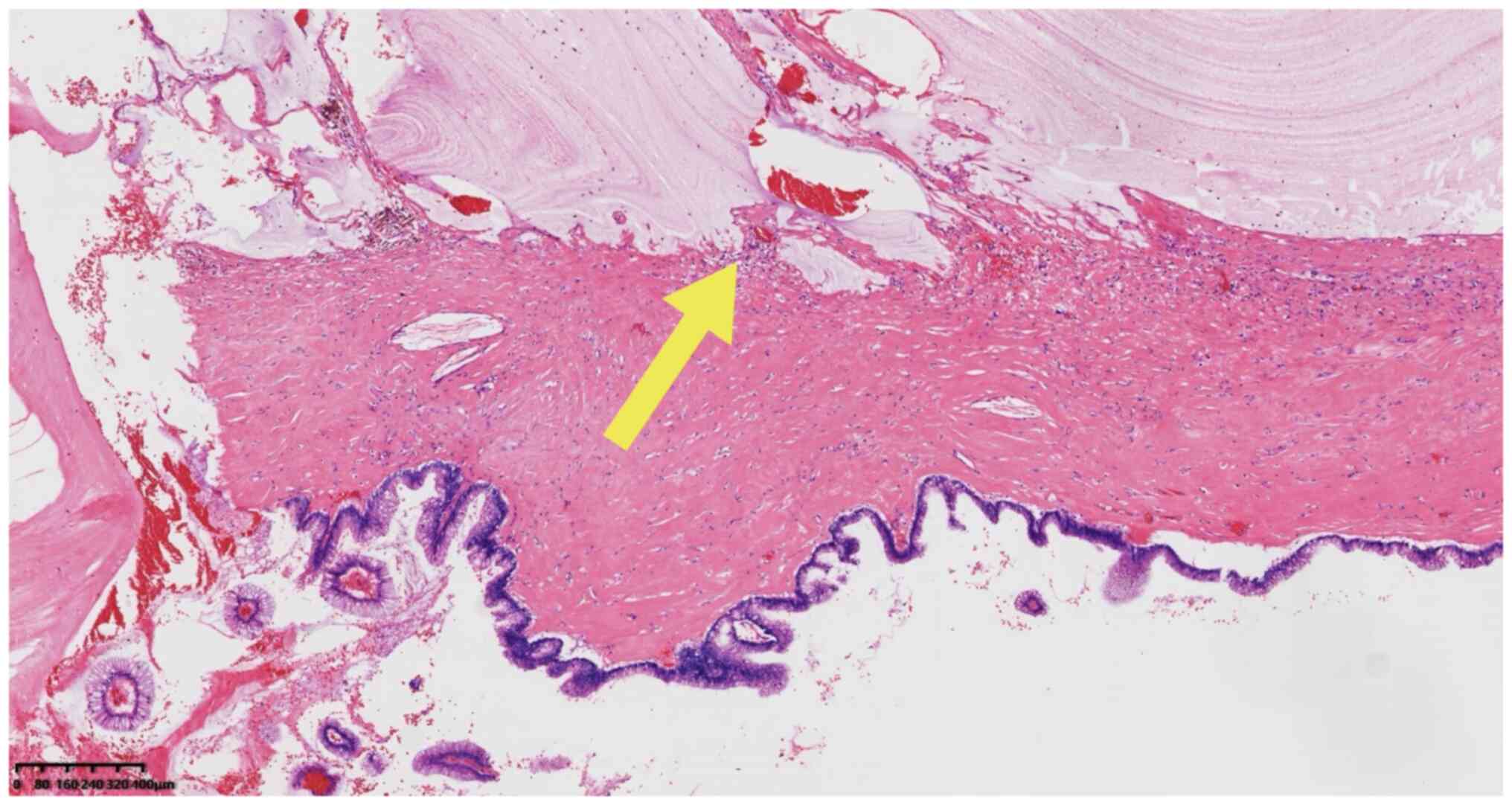|
1
|
Nguyen M, Addicott B, Chu J, Parham D and
Kim E: Congenital cyst of the umbilical cord. Fetal Pediatr Pathol.
35:344–347. 2016.PubMed/NCBI View Article : Google Scholar
|
|
2
|
Netto GJ, Amin MB, Berney DM, Compérat EM,
Gill AJ, Hartmann A, Menon S, Raspollini MR, Rubin MA, Srigley JR,
et al: The 2022 world health organization classification of tumors
of the urinary system and male genital organs-part B: Prostate and
urinary tract tumors. Eur Urol. 82:469–482. 2022.PubMed/NCBI View Article : Google Scholar
|
|
3
|
Humphrey PA, Moch H, Cubilla AL, Ulbright
TM and Reuter VE: The 2016 WHO classification of tumours of the
urinary system and male genital organs-part B: Prostate and bladder
tumours. Eur Urol. 70:106–119. 2016.PubMed/NCBI View Article : Google Scholar
|
|
4
|
Amin MB, Smith SC, Eble JN, Rao P, Choi
WW, Tamboli P and Young RH: Glandular neoplasms of the urachus: A
report of 55 cases emphasizing mucinous cystic tumors with proposed
classification. Am J Surg Pathol. 38:1033–1045. 2014.PubMed/NCBI View Article : Google Scholar
|
|
5
|
Wang D and Sule N: Mucinous cystadenoma of
the urachus and review of current classification of urachal
mucinous cystic neoplasms. Arch Pathol Lab Med. 143:258–263.
2019.PubMed/NCBI View Article : Google Scholar
|
|
6
|
Wu J, Liu A, Chen A and Zhang P: Urachal
borderline mucinous cystadenoma: A rare case report and literature
review. Medicine (Baltimore). 96(e8740)2017.PubMed/NCBI View Article : Google Scholar
|
|
7
|
Chen L, Wei N, Zhou G, Hou Y, Cheng J and
Lu C: Low malignant potential mucinous cystic tumor of urachus:Case
report. Chin J Med Imaging Technol. 37(1254)2021.(In Chinese).
|
|
8
|
Miao J, Shang P, Huang Y and Zhao X: Low
malignant potential mucinous cystic tumor of urachus-Case report.
Chin J Diffic and Compl Cas. 20:1263–1265. 2021.(In Chinese).
|
|
9
|
Brennan K, Johnson P, Curtis H and Arnason
T: Urachal mucinous cystic tumor of low malignant potential with
concurrent sigmoid colon adenocarcinoma. Case Rep Gastrointest Med.
2019(1434838)2019.PubMed/NCBI View Article : Google Scholar
|
|
10
|
Schmeusser B, Wiedemer J, Obery D, Buckley
K and Yu M: Urachal mucinous cystic tumor of low malignant
potential in a polymorbid female: A case report and review of the
literature. Int Cancer Conf J. 11:104–108. 2022.PubMed/NCBI View Article : Google Scholar
|
|
11
|
de Bree E, Witkamp A, Van De Vijver M and
Zoetmulde F: Unusual origins of Pseudomyxoma peritonei. J Surg
Oncol. 75:270–274. 2000.PubMed/NCBI View Article : Google Scholar
|
|
12
|
Mukherjee A, Parvaiz A, Cecil TD and Moran
BJ: Pseudomyxoma peritonei usually originates from the appendix: A
review of the evidence. Eur J Gynaecol Oncol. 25:411–414.
2004.PubMed/NCBI
|
|
13
|
Carr NJ, Finch J, Ilesley IC,
Chandrakumaran K, Mohamed F, Mirnezami A, Cecil T and Moran B:
Pathology and prognosis in pseudomyxoma peritonei: A review of 274
cases. J Clin Pathol. 65:919–923. 2012.PubMed/NCBI View Article : Google Scholar
|
|
14
|
Yan TD, Sugarbaker PH and Brun EA:
Pseudomyxoma peritonei from mucinous adenocarcinoma of the urachus.
J Clin Oncol. 24:4944–4946. 2006.PubMed/NCBI View Article : Google Scholar
|
|
15
|
Agrawal AK, Bobiński P, Grzebieniak Z,
Rudnicki J, Marek G, Kobielak P, Kazanowski M, Agrawal S and Hałoń
A: Pseudomyxoma peritonei originating from urachus-case report and
review of the literature. Curr Oncol. 21:e155–e165. 2014.PubMed/NCBI View Article : Google Scholar
|
|
16
|
Stenhouse G, McRae D and Pollock AM:
Urachal adenocarcinoma in situ with pseudomyxoma peritonei: A case
report. J Clin Pathol. 56:152–153. 2003.PubMed/NCBI View Article : Google Scholar
|
|
17
|
Shinohara T, Misawa K, Sano H, Okawa Y and
Takada A: Pseudomyxoma peritonei due to mucinous cystadenocarcinoma
in situ of the urachus presenting as an inguinal hernia. Int J Clin
Oncol. 11:416–419. 2006.PubMed/NCBI View Article : Google Scholar
|
|
18
|
Paner GP, Lopez-Beltran A, Sirohi D and
Amin MB: Updates in the pathologic diagnosis and classification of
epithelial neoplasms of urachal origin. Adv Anat Pathol. 23:71–83.
2016.PubMed/NCBI View Article : Google Scholar
|
|
19
|
Sugarbaker PH, Verghese M, Yan TD and Brun
E: Management of mucinous urachal neoplasm presenting as
pseudomyxoma peritonei. Tumori. 94:732–736. 2008.PubMed/NCBI View Article : Google Scholar
|
|
20
|
Gupta S, Singh G, Gupta A, Singh H, Arya
AK, Shrotriya D and Kumar A: Pseudomyxoma peritonei: An uncommon
tumor. Indian J Med Paediatr Oncol. 31:58–61. 2010.PubMed/NCBI View Article : Google Scholar
|
|
21
|
Adams E, Sepich-Poore GD,
Miller-Montgomery S and Knight R: Using all our genomes:
Blood-based liquid biopsies for the early detection of cancer. View
(Beijing). 3(20200118)2022.PubMed/NCBI View Article : Google Scholar
|
|
22
|
Cao J, Wang Y, Zhang Y and Qian K:
Emerging applications of mass spectrometry-based metabolic
fingerprinting in clinics. Adv Int Syst. 4(2100191)2022.
|
|
23
|
Li Y, Bao Q, Yang S, Yang M and Mao C:
Bionanoparticles in cancer imaging, diagnosis, and treatment. View.
3(20200027)2022.
|
|
24
|
Wang L, Zhang M, Pan X, Zhao M, Huang L,
Hu X, Wang X, Qiao L, Guo Q, Xu W, et al: Integrative serum
metabolic fingerprints based multi-modal platforms for lung
adenocarcinoma early detection and pulmonary nodule classification.
Adv Sci (Weinh). 9(e2203786)2022.PubMed/NCBI View Article : Google Scholar
|
|
25
|
Martínez A, Ferron G, Mery E, Gladieff L,
Delord JP and Querleu D: Peritoneal pseudomyxoma arising from the
urachus. Surg Oncol. 21:1–5. 2012.PubMed/NCBI View Article : Google Scholar
|
|
26
|
Bartoška P, Antoš F, Vítek P, Marx J,
Kopic J and Holečková P: Pseudomyxoma Peritonei. Klin Onkol.
32:329–332. 2019.PubMed/NCBI View Article : Google Scholar
|
|
27
|
Mohamed F, Cecil T, Moran B and Sugarbaker
P: A new standard of care for the management of peritoneal surface
malignancy. Curr Oncol. 18:e84–e96. 2011.PubMed/NCBI View Article : Google Scholar
|
|
28
|
Nozaki T, Yasuda K, Watanabe A and Fuse H:
Laparoscopic management of urachal mucinous borderline tumor
associated with pseudomyxoma peritonei. Surg Laparosc Endosc
Percutan Tech. 21:e152–e155. 2011.PubMed/NCBI View Article : Google Scholar
|


















